In 2016 we launched our course, 10ksubs, for the first time.
That launch brought $220k in sales.
Then a few months later we ran another sale and it brought in just over $500k.
What did we do to double sales?
We got other people to help us sell the course. We used affiliates.
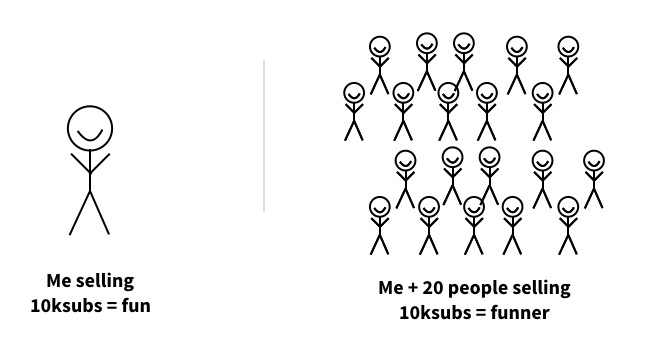
Today I’m going to show you how we setup and ran our affiliate launch plan.
You’re going to learn:
- Part #1: Explain what affiliates are and the basics of how an affiliate program works.
- Part #2: Show you our results from using affiliates in the last 10ksubs launch and give you an overview of our strategy.
- Part #3: Give you a step-by-step plan for how to do the same thing (recruit them, manage them, tech stuff etc.).
This is going to be meaty. So strap up.
Let’s gooooo….
 Get it Free FREE Bonus: Want to get my single best list-building strategy without reading thousands of words? Click the button to unlock a 24-hour pass to a new 15-minute training I created on the fastest way to build your list.
Get it Free FREE Bonus: Want to get my single best list-building strategy without reading thousands of words? Click the button to unlock a 24-hour pass to a new 15-minute training I created on the fastest way to build your list.
Part #1: What is an affiliate?
First off, there are three words I hear a lot around this topic and they all basically mean the same thing:
- JV
- Affiliate
- Partnership
“JV” and “affiliate” sound sketchy to me, so I usually defer to “partnership” when talking about this stuff. But “affiliates” is more widely used. So I’ll use that going forward. But if you see the other words being used around the interwebs, just know they’re synonymous.
Ok, onward.
What is an affiliate?
An affiliate is someone who sells your product for you in exchange for a % of the sales.
Still confused? STORY TIME!
Let’s say you’re a mailbox salesman…
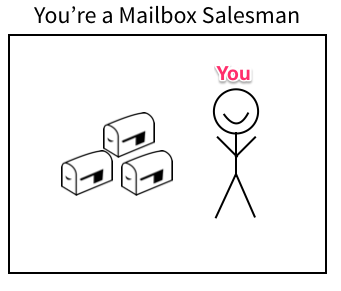
(I’m pretty sure that’s not a thing, but let’s roll with it for a minute.)
Your entire life, you’ve sold mailboxes door to door. You’ve had a good career. You’ve put food on the table and you stay pretty fit because you walk around all day.
Life is solid.
Then one day you meet a guy, Joe.
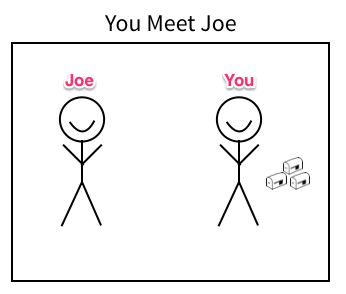
Turns out that Joe is a door-to-door salesman too!
Y’all hit it off. You tell war stories. You become besties.
But Joe doesn’t sell mailboxes. He sells knives.
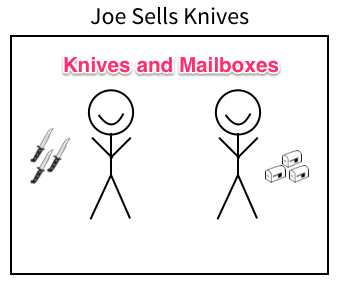
Then one day you’re taking and Joe has a brilliant idea. He says “Hey! What if I called up all of the people who have bought knives from me and tell them about your mailboxes?”
Makes sense. Someone who owns a house and buys knives is potentially in the market for a sexy new mailbox too.
So you make a deal. You agree to split the profits 50/50. Everything that Joe sells, he keeps half the profit.
Basically you don’t have to knock on more doors, but you bring in more customers and money.
That’s exactly how an affiliate program works.
- Your friend has a related audience.
- They agree to sell your product to their peeps.
- You split the profit.
Why is running an affiliate program a smart thing to do?
Go back to the mailbox salesman story.
His income has a ceiling. The number of people he can actually sell to is limited based on the number of doors he can knock on.
Let’s say that 1 out of every 10 (10%) people he talks to buys from him. And let’s say his take-home pay from each sale is $10.
If he knocks on 50 doors a day, how much will he make?
50 doors knocked on x 10% = 5 sales. Or $50.
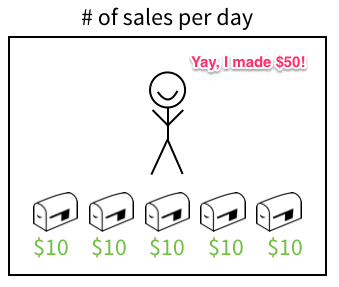
And that’s pretty much his earning potential. He can’t physically knock on more doors, which means he can’t make more money.
His monthly income is $1,100 ($50 x 22 working days per month).
But check out what happens when his buddy Joe “The Knife Salesman” gets involved.
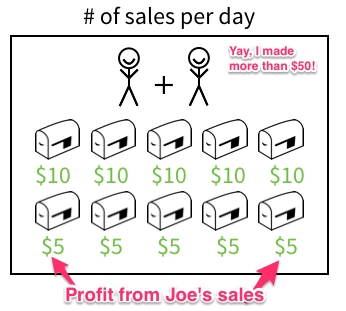
He’s able to sell 5 more mailboxes per day. Which is an additional $550 per month.
Now, what would happen if he went and met 10 other door-to-door salespeople and struck up a similar deal with them?
What would that look like?
This is what that would look like…
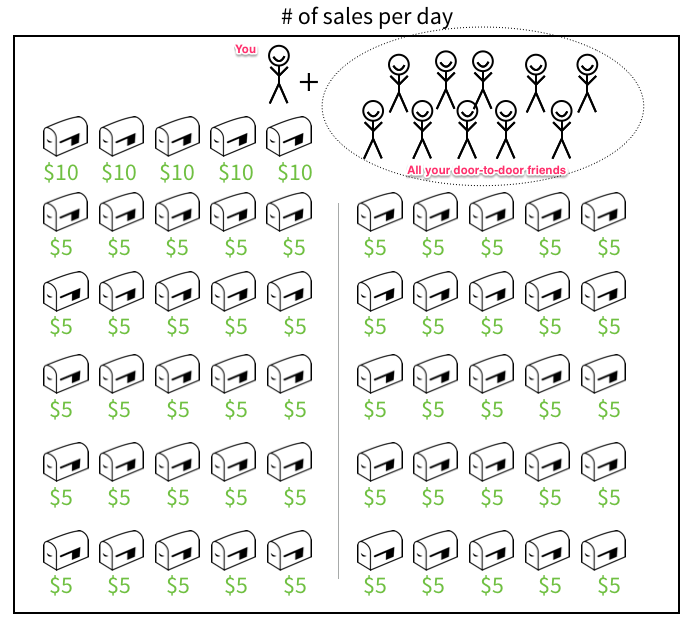
With his friends he can make $6,600 per month.
Without his friends he can only make $1,100 per month.
In conclusion: It’s really fun selling something by yourself. It’s a whole lot funner (and more effective) to do it with 20 other people. That’s why an affiliate program is a good idea.
Side note: Doing this stuff doesn’t make you a weirdo.
Obviously we aren’t door-to-door salespeople and we don’t want to be annoying when we sell our stuff. And I don’t want you to get the idea that only people in the yellow highlighter internet marketing crowd run affiliate programs.
There are tons of huge Fortune 1,000 companies that use this same basic strategy in their businesses.
Here are a few:
Infusionsoft
Pepsi
Tesla
IBM
Microsoft
There are a ton of white hat smaller businesses that do it too:
ConvertKit
SumoMe
LeadPages
Teachable
Why would running an affiliate program might not be a smart thing to do?
1. It takes more time and work.
Putting together all the pieces of an affiliate program is no small task. If you’re in a hurry, don’t have a team or just aren’t a fan of doing more work, don’t do this.
2. You aren’t trying to get more customers right now.
Not everyone’s primary goal is getting new customers. And that’s ok. There are a lot of valid reasons not to be focused on that. Like…
- You have plenty of existing customers.
- You currently are serving your existing customers well and want to focus on them.
- You’re building a lifestyle business and hyper-growth isn’t the be-all and end-all of your list.
- Other stuff.
3. It feels weird to you.
Saw a great quote the other day from Laura Roeder:
“If something doesn’t feel right to you, ditch it. If you’re drawn to something no one has done before, give it a try!”
I love this.
So, if you read about affiliate programs, give it a try and it doesn’t feel like a good fit, ditch it. There are plenty of other things you can do to grow your business. This is just one option. Follow your gut here (but don’t be a wimp).
4. This is the first launch of your product.
If this is the first time for you to launch your product, don’t invite other people to help you sell it. That’s a bad idea for a lot of reasons.
- The product isn’t proven yet.
- You have no idea what your sales numbers will be (which makes it harder to recruit).
- You’re going to have 1,000 other things to focus on and panic about. Don’t add something complex like this to the mix.
So, how do you know if you should run an affiliate program?
First off… you’re the entrepreneur. Figure it out!
🙂
Here are a few questions you can answer to help you.
Question #1: Do I have a product that has sold well to my existing audience?
Question #2: Do I have 50-100 hours to dedicate to running the program?
Question #3: Can I handle the support and infrastructure costs of doubling or tripling my customer base?
Question #4: Does this feel right to me?
If your answer to all four of these is YES, then you probably should do it.
If not, meh. You should probably wait.
..
Alright, let’s move on. By now you should get the basic concept of what an affiliate program is and why it’s smart (sometimes) to run one.
Let’s look at a case study of our first affiliate program so you can see what can happen when you run one.
Part #2: Results from using affiliates in the last 10ksubs launch and an overview of the strategy
Two things…
Thing #1: This post (as well as this entire site) is never intended to showcase our results or emphasize what WE are doing. It’s about you.
Throughout this post I’m going to share revenue figures and other numbers, but know the point of that is to show you an actual case study and give you an idea of what’s possible. Not to brag or anything like that.
Thing #2: There are a lot of different ways you can run an affiliate program. This is just one way. So if you know of any improvements or tweaks we can make, leave them in the comment section below. I’d love to learn from you.
…
Ok, first I want to show you the results of our first affiliate program we ran last fall.
A few key numbers:
We recruited 12 total affiliates.
They generated 20,000 new email subscribers (leads) for us.
The 10 affiliates emailed a combined 52 times about the launch.
We generated 125 total sales from affiliates.
That resulted in $160,000 in revenue from affiliates (split 50/50).
Other interesting numbers:
Affiliates who did a no-pitch workshop with me 90 days before the launch converted their leads 2x-3x better than those who didn’t.
3 affiliates accounted for 75% of all sales.
Not a number but: I hired my friend Darrell to help me manage the program.
How did it all work?
There were four main phases:
Phase #1: Recruit people to promote your product.
Phase #2: Work out a specific promo plan for each person.
Phase #3: During the launch, communicate daily and make sure everyone has everything they need.
Phase #4: After the launch, pay up and set up the next launch.
Here is how all four phases laid out visually (click to zoom in):

Here is a quick overview video of me talking through each phase as well:
Now you should have a good idea of what’s possible with an affiliate launch as well as a decent handle on the high-level strategy of how to execute an affiliate program.
In the 3rd section of this article, I’m going to take you through each of the 4 phases and show you in detail how we executed each and how you can do the same thing.
Note: Want to skyrocket your affiliate revenue over the next 90 days? Book a complimentary strategy call with one of our certified coaches.
Part #3: How we ran our affiliate program (and templates to help you do the same)
Quick recap of what we’ve learned so far:
Learned Thing A: You can sell a lot of your product by yourself, but there is a cap on how much you can physically do alone.
Learned Thing B: Getting your pals to sell your product is a rad way to break through that ceiling.
Learned Thing C: When you get people to sell your product and you pay them a commission, this is called an affiliate program.
Learned Thing D: There are four major phases of setting up and running an affiliate program.
Let’s go through each of the four major phases…
Phase #1: Recruiting people to sell your stuff for you (i.e. join your affiliate program)
The biggest mental block I had to starting our affiliate program was finding people to promote the product.
I struggled with that. Bad.
“Would people want to team up with me?”
“Where would I find them?”
“Would it ruin my relationship by asking them?”
Just like every other fear I’ve encountered in life, these were all mostly unfounded.
Here is what I learned:
There are four types of people who will potentially team up with you:
Type #1: People you know
Type #2: People you kinda know
Type #3: People you don’t know
Type #4: Past affiliates
If you’re like me, your tendency is to dream big. And then to look at how hard that dream is going to be to achieve and then get discouraged at how utterly impossible that dream is and write off the entire project.
For example…
When I was first putting together a dream list of people who would promote 10ksubs, I wrote down a long list of names, including Noah Kagan and Ramit Sethi.
I have a good relationship with Noah, so that seemed kinda sorta possible. But Ramit I don’t really know at all, so that seemed like a long shot.
The more long shots I wrote down, the more discouraged I got that any of them would help out.
Then I realized that is a stupid way to approach things.
Who is more likely to collaborate with you: someone you know or someone you don’t know?
Duh.
That’s when I realize the way I was going about this was backwards. Instead of starting with people I didn’t know (or folks I thought would be really tough to land), I should start with people I actually have a relationship with.
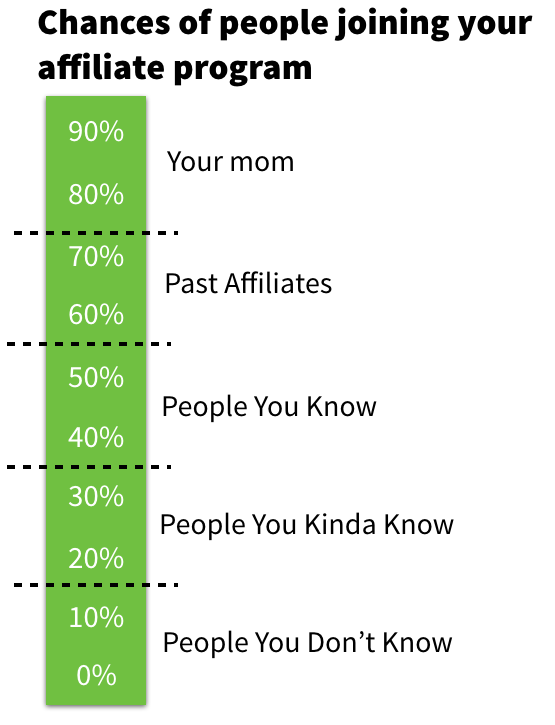
So we started at the top of this chart and worked our way down.
I’ll walk you through how we reached out to each group…
Step #1A: Make a list of people you know.
Who do you know that has an audience that would be interested in your product?
Jot their names down.
Here was my initial list:
![[image]](https://videofruit.com/Skitch/IMG_3383_JPG_1C9B0AEF.png)
If you’re struggling to put together your list, here are a few things that can jar your memory and get you going:
Exercise #1: Look at your recent Twitter conversations. Who are you talking to regularly?
Don’t try to judge audience size at this stage. Just brainstorm your list out.
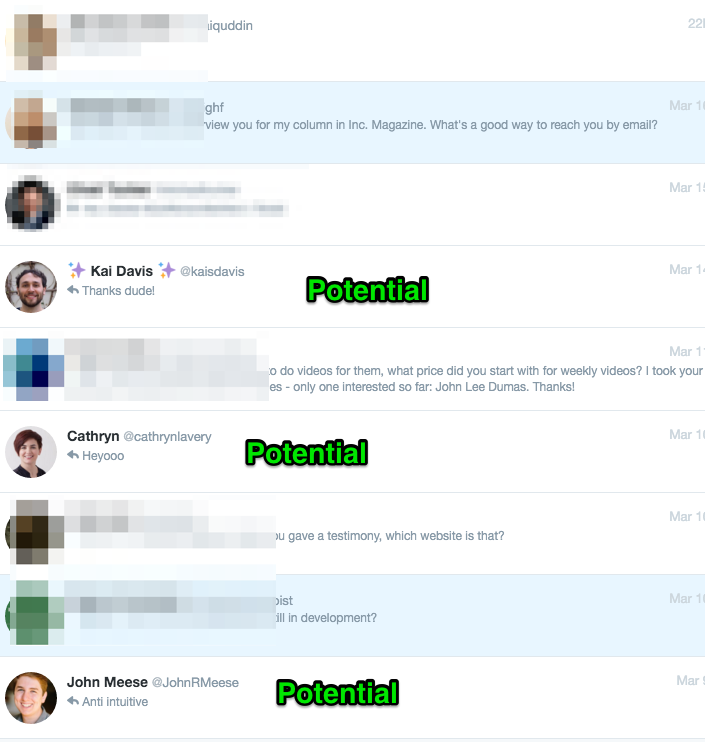
Exercise #2: Look at any Slack or Facebook groups you are in. Anyone there you know who could be a good fit?
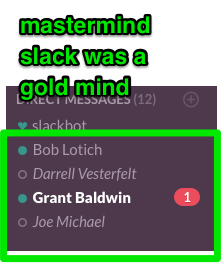
Exercise #3: Look at private messages on Facebook and email conversations you’ve had with people.
Exercise #4: If you sell a product, coaching or a service of any sort, look through your client lists. Anyone there you know with a related audience?
Exercise #5: If you’re just starting out, look in the communities of the products you’ve bought. Example: If you bought 10ksubs, look for other students in the 10ksubs Slack and FB groups who might be a good fit.
Exercise #6: Look at your phone. Who have you been texting and calling? Any friend who has a platform of any sort?
Your goal should be to make a list of 10-15 people you know who could be potential fits.
If you fall short, no worries. Do your best and move on.
Step #1B: Contact each person on your list and invite them to be an affiliate.
At this point you have a list of potential affiliates and not much else.
Perfect.
Before you spend any time building affiliate portals, writing swipe copy, figuring out commission splits and the other details, reach out to the people you’re the closest to (that list you just made) and get 2-3 commitments.
Side note: Pretty much the worst-case scenario is for you to spend 2 weeks fretting over all the small decisions only to realize you can’t get your closest friends to commit (because if they won’t, getting complete strangers will be 10x harder).
Here is an example of how I reached out to a few friends…
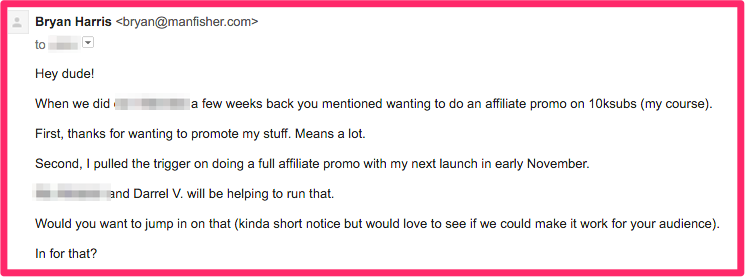
^^ reference back to previous conversation approach
Here is another example…

^^ super causal approach
And another…
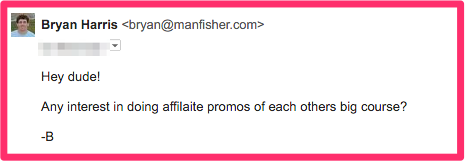
One more…
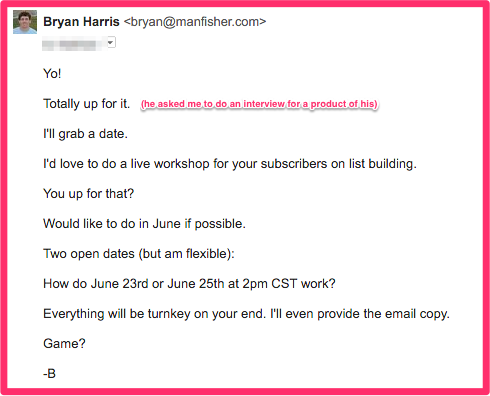
^^ Reciprocal activity. We used the workshop as an entry point, then turned them into an affiliate.
…
A few notes:
I highly recommend not using a template for every person you reach out to. Templates feel weird. Be a human and write like you write. Talk like you talk.
If you normally never email, don’t send an email invitation.
Use whatever channel you normally use to communicate with these people, and have a normal conversation with them in which you bring up your affiliate program.
Don’t be a weirdo.
🙂
Things you need to have together before reaching out:
You’ll need to have a handful of things together before starting your outreach.
1) Your product. Should be 100% finished and launched at least once.
2) The primary dates of your next launch: pre-launch promo, open cart, close cart
3) Conversion numbers from your last launch: # of subs on your list last time, # of sales, average $ per sale
Action Items for Step 1A and 1B
Action Item #1: Make a list of every person you know (use the questions above to help you).
Action Item #2: Reach out to each person and invite them to be an affiliate. (Use the scripts above as guidelines)
Note: As you reach out, if folks start asking you a bunch of questions you don’t know the answers to, tell them you are still working out all the details and you’ll get back to them on the exact specifics.
Then write down those questions and come back to them.
Your primary goal of this step is to get 2-3 people committed to being affiliates. That’s your validation criteria for continuing to build the program and reach out to more people.
Step #2A: Make a list of people you kind of know.
Now, let’s move on to people you kind of know (but don’t know really well) who have audiences that would be interested in your product.
When talking with people you know well, you can be direct and to the point. When dealing with people you don’t know that well, you’ll need to take things a bit more slowly or risk burning bridges and forever killing any chances of working together.
Before we jump into the tactical part of how you should approach these folks, first you need to put together a list of people to contact.
People you kind of know are folks who you may have met one time, talked to a time or two with via email or have a bunch of friends in common but have never actually talked to directly before.
Here are a few places you could look:
Who have you had in-person conversations with?
Who have you met at conferences in the last 12 months?
Who have you met at local meet-ups?
Who are you friends with?
Who have you had online conversations with?
Who have you worked for?
Who have you linked to or mentioned in your blog posts?
Example: Sujan Patel runs a content marketing agency and owns a few SaaS apps. We’re in the same space, online marketing, but have never talked directly until this Twitter conversation a few months back.
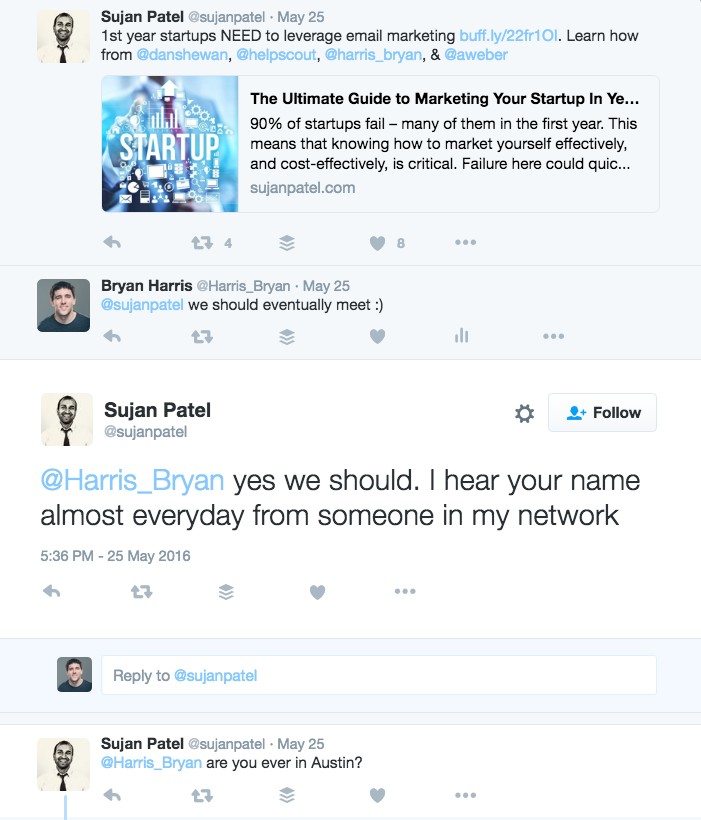
Based on our relationship. as of this conversation it would be super awkward if I pitched him on promoting my product to his audience. But with a little nurturing, some type of promotion of each other’s products could make sense.
Step #2B: Contact each person and turn them into someone you know well.
How do you get people you only kind of know to promote your product?
You don’t.
Only people you actually know and have a relationship with will promote your stuff. The key is turning the people that only kind of know you into people who know you well.
Here are 4 quick steps we followed to do that:
First, remind them/let them know you exist.
People are busy. The people you really want to promote your product are very busy. And most likely they aren’t sitting around thinking about you at night. So your first step is to remind them you exist.
An easy and natural way to do that is to comment on a piece of content they’ve produced recently. Look back over their last few blog posts and podcasts until you find something you really like and tell them.
Text them, email them, DM them… whatever your normal channel of communication is. Just tell them they did a good job.
Here is an example of that in action (names removed to protect the innocent):

The goal here is to pop back up on their radar and remind them you exist.
Second, build reciprocity by helping the other person out.
Once you are back on the person’s radar, build reciprocity by helping them.
One easy way to do that is to share their content or product with your audience.
We didn’t do this for our latest launch, but our bi-weekly roundup emails are a great place to do that:
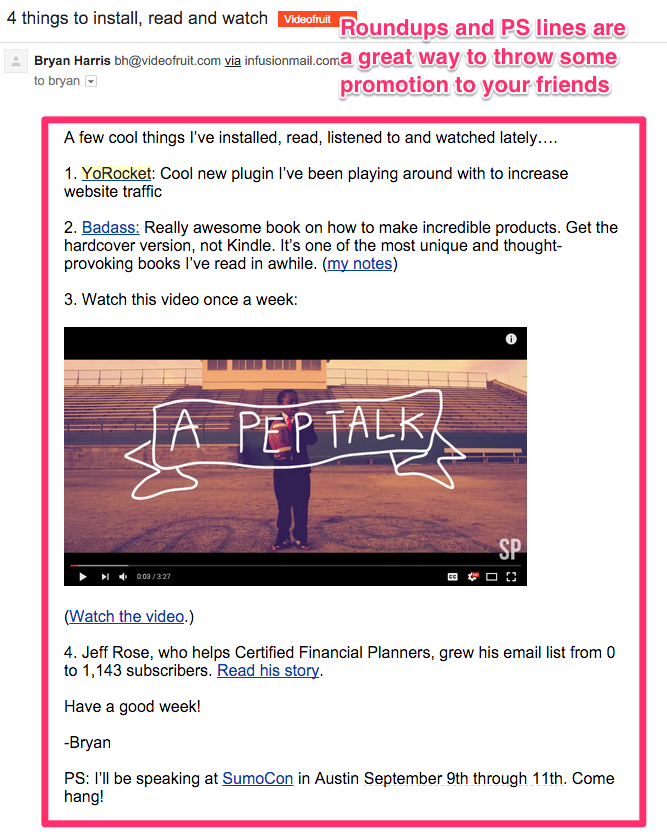
If it makes sense in the context of your relationship, tell the person about your promotion.
Something like…
“Hey dude, loved that article about XYZ. Shared it today to the list. Getting a lot of good responses to it INSERTIMAGEOFRESPONSE. Rock on!”
Third, once you’re back on their radar and you’ve built some reciprocity into the relationship, it’s usually a good time to gauge their audience’s interest in your product. To do this, give them free information in the form of a guest post, podcast interview or even a no-pitch workshop.
Here is an example of how we took a podcast interview and followed up with a request for a no-pitch workshop (that generated 4k leads):
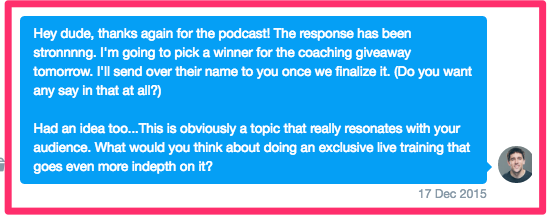
Lastly, once the audience has proven interest in the topic, use that interest to go in for your big ask.
You’ve done all of your homework at this point.
You haven’t moved too quickly. You’ve provided massive value in the form of sharing their content and serving their audience, and their audience has shown interest in your topic. Now it’s time to ask them to promote your product.
At this point it should be a no-brainer for them.
Something like…
*”Hey dude, the workshop/podcast/guest-post last week was awesome! Your people love it. *
Here are a few messages we got after the workshop/podcast/guest-post.
[INSERTIMAGE]
[INSERTIMAGE]
In X weeks we’re launching our product INSERTNAME. Would love to chat about teaming up to promote it if you think it’d be a win for your peeps.
If that’s of interest, just let me know.
If not, no biggie.
Chat soon,
-YOURNAME”
Action Items for Step 2A and 2B
Action Item #1: Make a list of everyone who meets these two criteria 1) You want them to promote your product to their audience. 2) You sorta know them.
Action Item #2: Go through all four steps described above (1. Remind them you exist 2. Build reciprocity 3. Gauge their audience’s interest 4. Ask them to be an affiliate).
Your primary goal of this step is to get 3-5 people committed to being affiliates. This process might take up to 3 months, so give yourself time. Don’t rush things. Relationships are everything.
Step #3A: Make a list of people you don’t know.
Now let’s talk about people you don’t know at all.
Everyone generally wants to start with the big industry names that have massive followings. But the problem is that you have no personal relationship with these people.
In reality these are the least likely to promote your product and the most likely to get really annoyed if the first conversation you have is you trying to pitch them.
The best way to approach these types of people is the same way you’d like to be approached.
- Prove that you’re not a weirdo internet person.
- Show them you have chops.
- Help them before you ask for them to help you.
We’ll get into each of those steps in a minute.
But first, let’s create a list of who these people are.
Here are a few places you could look to put this list together:
Who shows up in Google when searching on your primary topic?
Who has the top-rated podcast on your topic?
Who are the most popular bloggers on this category?
Who are the industry leaders in shoulder categories?
Who has the most shared content on your category?
Spend 15 minutes and make a list of 15-20 people who fit this criteria.
Step #3B: Contact each person and turn them into someone you kind of know.
Now that you have a list of people you’d love to be affiliates for you, your goal is to take those people from not knowing you at all to knowing you a little bit.
My favorite way to do that is to start by first proving to them you’re not a weirdo internet person by showing them your results.

We’ve talked about this approach extensively in the past. Read here for more detail.
There are many ways you can meet people and get to know them. This is one. Use your own social intelligence and experience to navigate this process. Very rarely do cookie-cutter processes work if you don’t adapt them to each situation and your own skill set.
Action Items for Step 3A and 3B
Action Item #1: Make a list of 20 people you don’t know but would like to get to know and who, in a perfect world, would promote your product.
Action Item #2: Start building relationships with each of these 20 people.
Action Item #3: Once you have a solid relationship with someone, invite them to be an affiliate.
Tip: You won’t become friends or get to know even half of these people. That’s ok. Don’t be pushy. Don’t be weird. And don’t just skip to pitching them. Take your time, go slow and let the relationship develop.
Phase #2: Make it simple for your affiliate to promote.
The results of Phase #1 should be that you have a group of 10-20 committed affiliates.
Now you need to make it simple to promote your product.
To do that you’ll need a handful of things:
- One-page information sheet: This includes all of the major details of your launch that they’ll need.
- Affiliate portal: This will allow each affiliate to track all of the leads and sales for your launch.
- Swipe file: The word-for0word email scripts that your affiliates will use (or model) to promote your product.
- Strategy call: A personal phone call with each affiliate to work out their specific promotional strategy.
Let’s talk about each
Action Items:
Action Item #1: Create your one-page info sheet for your affiliates and send it to all of them.
Action Item #2: Choose your affiliate software and set up your portal.
Action Item #3: Create your affiliate swipe copy.
Action Item #4: Schedule a call with all of your affiliates to go over their unique promo plan.
Phase #3: During the launch, communicate daily and make sure they have everything they need.
At this point you have your affiliates committed to promote your product, you’ve created all of your the marketing assets that your affiliates need to promote and you’ve custom-tailored a launch plan for each one of them.
Now it’s launch time!
There are several important things you’ll need to do during your launch to make sure your affiliate stay engaged and execute the plan you’ve outlined.
Thing #1: Send personal email updates about the launch.
Many launches rely solely on broadcast messages to all of their affiliates in order to communicate what’s happening on each day of the launch.
We’ve found that individual emails sent to each affiliate are more effective.
It’s good practice to include all of the following in each day’s update email:
- How many leads they have sent into the launch (email subscribers that are potential sales for them)
- How many sales they have made (including total revenue and their commission split)
- What’s happening in the launch over the next 24-48 hours (upcoming webinars, bonuses, etc.)
- If you are running a contest (more on that in a minute), show them how they stack up to the competition.
- What swipe file do they need next in order to execute their custom promo plan
- Encourage each affiliate with new ideas when/if they present themselves.
- Create competition between affiliates who know each other.
- Answer questions and make it simple for each affiliate.
A typical daily update email might look something like this…
Hey Joe,
Great job yesterday sending over 500 new leads in!
That puts you into 2nd on the lead competition leaderboard (2nd only to Grant).
A few quick hitters for you…
*Total leads: 1,253*
*Total sales: $54,325*
*Your commission: $27,162*
Next 48 hours:
Over the next 48 hours we’ll be expiring the weekend bonus and starting to heavily promote Tuesday/Wednesday’s webinar. The webinar is one of the highest converting events of the launch. Def recommend pushing it if you can.
The next scheduled email you had up was for close cart.
Click here for the close cart swipe.
If you want to promote the webinar, I think you can push by Grant on the lead’s competition leaderboard and take home the $10,000 prize. Based on your opt-in numbers in the first few days of the launch, I think you could get another 400-800 leads which should take it for you.
If you do want to promote that, here is a link for you.
…
Holler if you have any questions!
If you want to get me on my cell, here is my number PHONENUMBER
-Bryan
Thing #2: Award affiliates who do well.
One thing that we found to be extremely effective is telling affiliates when their promotions are working really well.
For example:
We had one affiliate on our last launch who committed to only sending 1 email. But that one email produced over 2,000 leads and $20,000+ in sales. Obviously, the email was effective.
So, I pinged him and let him know how crazy well the email worked. That one little ping resulted in him sending 3 more emails.
Motivating your affiliates to send more emails than planned (when it makes sense) can produce big results.
Another great way to do this is by offering prizes to affiliates who send in the most leads and produce the most sales.
Here are the prizes we offered our affiliates:
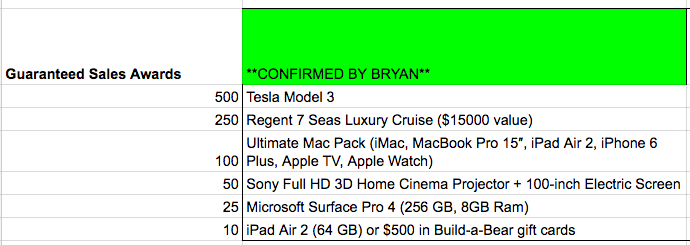

We’ve found that by offering performance-based prizes, you can bring out the competitive spirit in affiliates and get them to promote more and push just a little harder than they would have otherwise.
Also, may affiliate launches use placement-based prizes (like 1st place gets X and 2nd place gets Y). While placement based prizes are attractive, we’ve found that offering performance-based prizes (if you sell X copies, you get Y), work almost just as well and mitigate your risk of offering prizes that are worth more than the profit you generated from the affiliate who won the prize.
Thing #3: Send broadcast email updates every 2 days.
With larger affiliate launches it can be nearly impossible to send a personalized email update to every affiliate every day of the launch.
In that case, we’ve found broadcast email updates work well.
The key is to regularly communicate with your affiliates.
Here is an example of what that may look like:
Hey Joe,
For a quick update on your leads and sales numbers click here.
Yesterday was really fun. We had 97 new students join the course and already have several people making progress.
Here is one student who posted in the community:
IMAGEINSERT
Next 48 hours:
Over the next 48 hours we’ll be expiring the weekend bonus and starting to heavily promote Tuesday/Wednesday’s webinar. The webinar is one of the highest converting events of the launch. Def recommend pushing it if you can.
Click here for a few sample emails/hooks you can use to invite your audience to the webinar.
…
Holler if you have any questions!
If you want to get me on my cell, here is my number PHONENUMBER
-Bryan
Wrapping it all up
And that’s how we ran our first affiliate launch and how you can do the same thing.
That’s nearly 6k words of stuff.
Let’s review the highlights:
What is an affiliate?
An affiliate is someone who sells your product for you in exchange for a % of the sales.
Why is running an affiliate program a smart thing to do?
It’s a fantastic way to grow your list and nearly instantly reach many times the number of customers you could reach with your own audience.
Should you run an affiliate program?
Here are a few questions you can answer to help.
Question #1: Do I have a product that has sold well to my existing audience?
Question #2: Do I have 50-100 hours to dedicate to running the program?
Question #3: Can I handle the support and infrastructure costs of doubling or tripling my customer base?
Question #4: Does this feel right to me?
If your answer to all four of these is YES, then you probably should do it.
What type of results did we have when we used an affiliate program?
A few key numbers:
We recruited 12 total affiliates.
They generated 20,000 new email subscribers (leads) for us.
The 10 affiliates emailed a combined 52 times about the launch.
We generated 125 total sales from affiliates.
That resulted in $160,000 in revenue from affiliates (split 50/50).
How did we run the program?
Phase #1: First we recruited people to be affiliates.
Phase #2: Then we made it easy for them to promote our product.
Phase #3: We communicated with them throughout the promo.
…
Think you’re ready to run your own affiliate program but still have questions?
Leave your question in the comment section below. I’ll be personally reading and responding to all questions.
Schedule a free call with a Growth Tools coach!